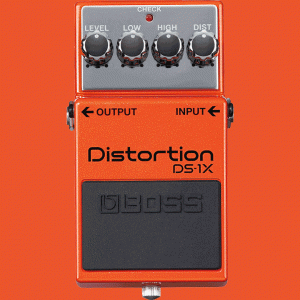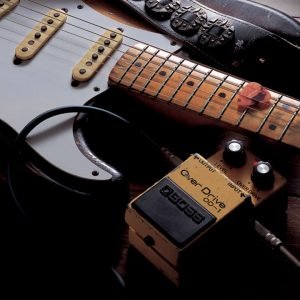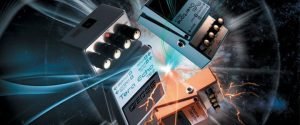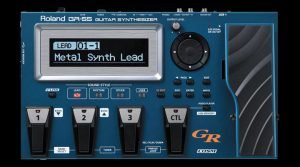Contributed by Roland UK Team
Paul White, editor-in-chief of the esteemed Sound on Sound magazine looks at some practical applications of guitar synthesis on the GR-55 guitar synth. (Hint: It’s not about playing drums on your guitar.)
The GR-55 guitar synth combines two of my favorite Roland guitar technologies in a pedal format specifically designed not to intimidate the musician, and I had plenty of time to play with one when I reviewed it for Sound On Sound. One is the fast-tracking, sample-based sound synthesizer section, the other is COSM guitar/amp/effects modeling. Critics of “guitar synths”often cite the need for an additional hex pickup, or the use of a guitar already fitted with one (such as the new GC-1 GK-Ready Fender Stratocaster®) as being an unwelcome inconvenience, but in reality neither of these highly sophisticated processes would be possible without it. If you want to fire sampled synth sounds from a guitar, the electronics need to be able to track the pitch of each string quickly and reliably, and the only way to achieve this is to send it a separate signal from each string. When it comes to COSM modeling, the reason may be slightly less obvious as there are competing products that emulate different amplifiers and effects using a standard guitar with a single output. With Roland’s COSM modeling, however, the process extends to modeling the guitar itself in addition to amps, effects, speakers and so on. Once again separate string signals are needed to accurately model the effect of the pickup position on the guitar, especially if it is set at an angle as a Strat bridge pickup is. Alternate tunings and 12-string emulations also need separate string signals as different amounts of pitch shift have to be applied to each string.
Listen to more GR-55 sound examples
The GR-55 Guitar Synth Requires an Extra Pickup…
Fortunately, the slim GK pickup system is easy to attach to most guitars, providing there’s space close to the bridge. Fitting to Strats and similar guitars is easy — in fact few guitars pose real problems, though I have to concede that a Telecaster with a traditional “ashtray” bridge makes a less than ideal candidate. Then there are Roland compatible guitars from a number of top name guitar builders as well as the Fender® models mentioned, the latest being the GC-1 GK-Ready Strat®.
Pedal Versatility…
For my own studio and live work, I have a Roland GR-33 guitar synth and a VG-99 COSM guitar processor, and though each offers more features in its own specialized area than the GR-55 guitar synth, the advantages of combining both technologies in an easy-to-manage package are obvious, not least being simplicity of setup. You also get a pedal with the GR-55 guitar synth that can be assigned to different functions for each patch, controlling such things as volume, wah, modulation effects and so on. One of the limitations of the guitar, as opposed to a keyboard, is that the notes can’t sustain indefinitely, but it is possible to use the foot control to “hold” the sample-based synth sounds so you can create a sustaining synth pad and then play guitar over the top. When it comes to time to change chord, you release the switch, play a new chord and then hit hold again. There are also several hold modes that range from holding all the strings to just holding the ones that are playing so that you can continue playing melodies on the remaining strings after pressing the switch. If you want to play a Pink Floyd epic on your own, this is the box for you.
Mounting the GK Pickup is Easy…
 You can get a GR-55 guitar synth with or without a GK pickup. The supplied pickup parts allow for permanent mounting using screws or you can also use adhesive pads, which means you don’t need to modify your valuable guitar. The control box that also houses the cable connector can be fixed under the body strap pin so again no mods are needed. A single 13-pin cable connects the guitar to the GR-55 guitar synth, so there’s no need for a separate guitar cable — you can pick off the regular guitar signal around the back of the GR-55 guitar synth and feed it to your amp in the usual way.
You can get a GR-55 guitar synth with or without a GK pickup. The supplied pickup parts allow for permanent mounting using screws or you can also use adhesive pads, which means you don’t need to modify your valuable guitar. The control box that also houses the cable connector can be fixed under the body strap pin so again no mods are needed. A single 13-pin cable connects the guitar to the GR-55 guitar synth, so there’s no need for a separate guitar cable — you can pick off the regular guitar signal around the back of the GR-55 guitar synth and feed it to your amp in the usual way.
Features…
Before looking at applications, I’ll take a quick look at the key features of the GR-55 guitar synth, which is based around two separate synthesizer sound engines that can each access the same 910 voices covering both common instrument sounds and “obviously synthy” sounds. From strings to organs, to ethnic to pianos — it’s all there. The amount of editing you can do to these sounds is intentionally limited to make the thing easy to drive but there’s so much choice on offer that this really isn’t much of a restriction. In addition to these two synth sections, you get a full-on COSM modeling section that can be used at the same time. Here, you’ll find guitar modeling, amp modeling, speaker modeling, more effects than you can shake a whole bunch of sticks at, plus a few rather more synth-like sounds that are based on the guitar sound from the separate strings processed via Roland’s HRM harmonic restructuring process. I’m a big fan of these HRM sounds as they are derived directly from the guitar string output rather than from triggered samples.

HRM sounds respond accurately to your playing, and they can even be layered with the sounds of a conventional guitar to create something big and rich. On top of all this, you also get a simplelooper allowing loops of up to 20 seconds to be stored and replayed. And for instant gratification, there’s a huge library of preset patches to take you on a whistle stop tour of the GR-55’s capabilities.
EZ Edit: Simple Editing System…
As you’d expect, you can save your own settings or patches using any permutation of the two synth sounds and the COSM sound. And if the simple editing system seems like too much trouble, there’s also an extra easy edit option called EZ Edit where you can simply control the amount of effect or dial in a brighter or warmer sound.
Playing the GR-55 Live…
I’d like to introduce a practical tip at this point: synth sounds don’t always sound their best when played through a regular guitar amp as guitar amps are specifically designed to color the sound in a certain way. Fortunately the GR-55 guitar synth gives you the option of routing thesynth sounds to a separate amplifier, which could be a direct feed to the PA, a keyboard combo or even a small acoustic guitar combo such as one of the Roland AC range. For my own live work, I tend to send synth sounds directly to the PA (which means I can keep the sounds in stereo). For smaller bar gigs, I’ll use an acoustic guitar combo and make do with mono synths. However, a keyboard combo would be a safer bet if you like exploring those deep bass synth sounds.
 Another very neat feature for live work is the ability to plug-in a USB memory stick containing backing tracks and have them played back via the GR-55 guitar synth. That’s not something I’ve needed myself, but I can appreciate how useful it would be to those striving for a big band sound using only one or two performers. Similarly, the MIDI Out doubles as a V-link port allowing the remote control of video devices; again not a feature I’d use but some performers will welcome it as a way to add an extra dimension to their shows.
Another very neat feature for live work is the ability to plug-in a USB memory stick containing backing tracks and have them played back via the GR-55 guitar synth. That’s not something I’ve needed myself, but I can appreciate how useful it would be to those striving for a big band sound using only one or two performers. Similarly, the MIDI Out doubles as a V-link port allowing the remote control of video devices; again not a feature I’d use but some performers will welcome it as a way to add an extra dimension to their shows.
Using the GR-55′s MIDI Function…
The question often arises as to whether the GR-55 can be used with separate MIDI synths, sound modules or instrument plug-ins. Simply put, the answer is yes as the GR-55 guitar synth is fitted with MIDI In and Out sockets, and in the studio this is incredibly useful as you can use your standard guitar skills to play software synths and other hardware synths. Unless your playing is very clean, you may find some stray, low volume MIDI notes appearing in your recording, but it is a simple matter to use the piano roll editor in your DAW to identify and remove these if they’re audible.
I think that internal sounds trigger more “elegantly” than external synths because it’s inside the box. Roland’s engineers are able to bypass the MIDI layer altogether, speeding up the proceedings. This isn’t usually a problem, though one pitfall to be aware of is that you must set the external synth to the same pitch bend range as the GR-55, otherwise any bent or slurred notes will result in sonic chaos! You also need to be aware that most synths and modules come set up in Poly MIDI mode, which means you can’t bend each string independently. This setup is fine for simple chord and melody work, but if you want to use regular guitar bending techniques, and have the synth respond in the correct manner, you’ll need to set it to Mono mode. This allows it to behave as six separate mono synths receiving on six separate MIDI channels. This is easy enough to do on most polyphonic synths. If this is something you plan to do in the studio on a regular basis, the easiest option is to create a special song template in your DAW for use with MIDI guitar where you already have some software instruments loaded and set up appropriately.
How to Make the GR-55 Respond to Your Playing…
Now it might be that while all this sounds highly appealing, you’ve tried a guitar synth in a shop or played with a friend’s system and found it less playable than you expected. While it is true that the sampled synth sounds react better to a reasonably clean and positive playing style, the most common cause of poor performance is the GK pickup being installed incorrectly. The spacing between the strings and the pickup is important; it is why the mounting kit comes with spacers. If you follow the guidelines in the manual, you should end up with a system that behaves consistently well. It only takes a few minutes to get this right, and you only have to do it once. With the pickup correctly installed, there’s an easy setup procedure to ensure all the strings are equally sensitive, but again very quick and easy. And if you have more than one Roland Ready guitar, no problem as the GR-55 guitar synth can store setup details for all of them up to a maximum of 10 guitars. I like that the GR-55 is designed for guitar players, not techno-nerds!
Final Thoughts…
I’m not a keyboard player — I can’t get my head around something that forces you to learn a new scale shape every time you change key, so in the studio I use my Roland guitar-to-MIDI stuff all the time to play synth parts. You just have to remember to play in a way that is appropriate to the sound you’ve chosen — Steve Vai style speed licks on a Tuba or bowed bass patch really don’t translate particularly well! Live though, I love the COSM modeled 12-strings, the different amp sounds, the effects, the ability to hold pad sounds under my usual guitar sound and the ability to have something like an organ sound layered behind the guitar. Even used at a highly basic level, the GR-55 guitar synth can add a completely new dimension to your sound and leave your audience wondering exactly how you did it, and if you play in a covers band and need a custom guitar sound for every song, it will do that too.
Related Articles
BOSS SY-300 Guitar Synthesizer vs. ROLAND GR-55 Guitar Synthesizer
GR-55 Guitar Synthesis








